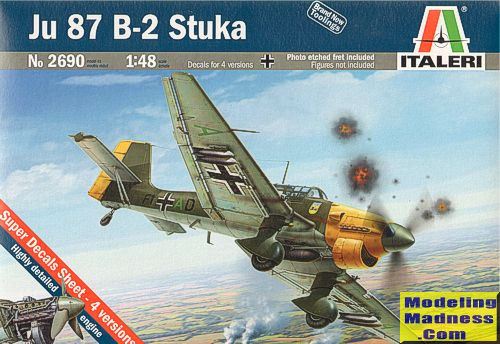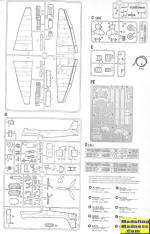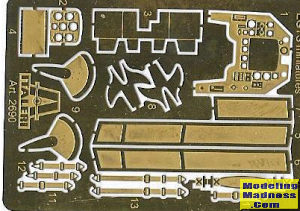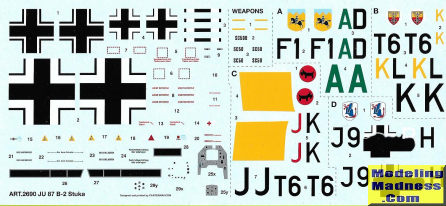
| KIT #: | 2690 |
| PRICE: | $40.00 |
| DECALS: | Four options |
| REVIEWER: | Francisco Santoro |
| NOTES: | Kit includes a photoetch fret, a rubber hose and a detailed engine. |

| HISTORY |
From the instructions: The Junkers Ju 87 Stuka was a two seat dive bomber/ground attack aircraft . Designed by Hermann Pohlmann, the Stuka first flew in 1935 and made its combat debut in 1936 as part of the Condor Legion during the Spanish Civil War. The aircraft was easily recognizable by its inverted gull wings, fixed undercarriage and its "wailing" siren. The Stuka´s design included several innovative features, including automatic pull-up dive brakes under both wings to ensure that the plane recovered from its attack dive even if the pilot blacked out from the acceleration. Although sturdy, accurate and very effective, the Ju 87 was vulnerable to modern fighter aircraft, like all other dive bombers of the war.
The Ju 87B series was the first mass produced variant. In total an estimated 700 Ju 87B-1s and 230 B-2s were delivered to the Luftwaffe, of which 550 were built by Junkers.
| THE KIT |
 Italeri´s Ju 87B-2 comes in side opening box, with all the sprues
coming inside another box. The art box shows Ju 87B-2 F1+AD dive-bombing over an
unknown area of Bulgaria in 1941.
Italeri´s Ju 87B-2 comes in side opening box, with all the sprues
coming inside another box. The art box shows Ju 87B-2 F1+AD dive-bombing over an
unknown area of Bulgaria in 1941.
Released in 2010, this model has 9 sprues, 8 molded in light grey and one clear sprue. They´re labelled with letters from A to E. Sprue A constains the wings (single piece lower wing), cockpit sidewalls, cockpit floor and stabilizers. Sprue B has the fuselage halves, engine parts, propeller and the rudder. Sprue C comes as a duplicate and has the wheels, dive brakes, landing gear covers and the Jericho trumpet propellers. Sprue D contains the bombs, most of which aren´t used, and the fuel tanks for an R-2 version (which hasn´t been released by the time of this preview being written). The final sprue, E, has the clear parts.
One neat detail of this kit is that the aileron actuators come as real, separate pieces unlike Hasegawa´s version, which come as solid triangles. Before the release of this model, modellers who desired to give their Hasegawa´s Ju 87B-2s extra realism had to cut and rework those actuators to make them resemble the real thing.
 The photoetch parts have 18 individual pieces, the bigger ones being
the control panel the radio-operator panel and the wing walk area. The smaller
parts are the seat belts. They´re produced by EGYS Miniatures. You´ll need to
use cyanocrylate to glue them.
A rubber hose
is include to simulate the engine wire.
The photoetch parts have 18 individual pieces, the bigger ones being
the control panel the radio-operator panel and the wing walk area. The smaller
parts are the seat belts. They´re produced by EGYS Miniatures. You´ll need to
use cyanocrylate to glue them.
A rubber hose
is include to simulate the engine wire.
The decal sheet is really well done, you can read what the stencils say with ease. The sheet is divided in two parts, the stencils common to the four versions (Iron crosses, dive brakes and fuel indicators). The sheet also has decals for the wing walk demarcation and instrument panels, so you can avoid using the photoetch for those two areas. The second part of the sheet is dedicated to the four different markings of each Stuka.
 Now, onto the options:
Now, onto the options:
A) Junkers Ju 87B-2 F1+AD, Stab III/StG 77, Bulgaria, 1941, painted in RLM 04/65/70/71.
B) Junkers Ju 87B-2 T6+KL, 3/StG 2, France, August 1940, painted in RLM 65/70/71.
C) Junkers Ju 87B-2 T6+JK, 2/StG 2, Russia, July 1941, painted in RLM 04/65/70/71.
D) Junkers Ju 87B-2 7/StG 1, France, summer 1940, painted in RLM 22/65/70/71.
| CONCLUSIONS |
A nice kit which is readily available and better detailed than Hasegawa´s Ju 87B-2. I also think you can make the R-2 version with the included parts. It will look good together with Airfix´s new Junkers Ju 87B-1.
Copyright ModelingMadness.com
If you would like your product reviewed fairly and fairly quickly, please contact the editor or see other details in the Note to Contributors.
Back to the Main Page Back to the Review Index Page Back to the Previews Index Page